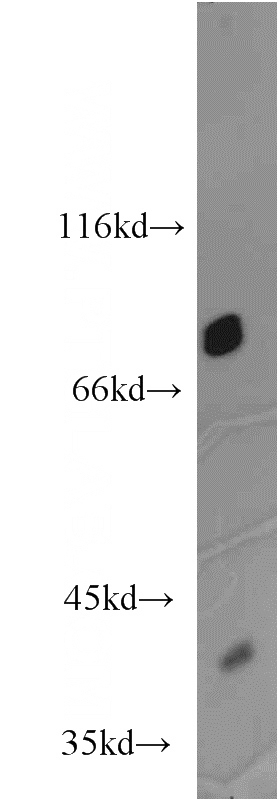-
Product Name
Zyxin antibody
- Documents
-
Description
Zyxin Rabbit Polyclonal antibody. Positive WB detected in HeLa cells, MCF7 cells. Observed molecular weight by Western-blot: 78kd
-
Tested applications
ELISA, WB
-
Species reactivity
Human; other species not tested.
-
Alternative names
ESP 2 antibody; HED 2 antibody; ZYX antibody; zyxin antibody; Zyxin 2 antibody
- Immunogen
-
Isotype
Rabbit IgG
-
Preparation
This antibody was obtained by immunization of Zyxin recombinant protein (Accession Number: NM_001010972). Purification method: Antigen affinity purified.
-
Clonality
Polyclonal
-
Formulation
PBS with 0.1% sodium azide and 50% glycerol pH 7.3.
-
Storage instructions
Store at -20℃. DO NOT ALIQUOT
-
Applications
Recommended Dilution:
WB: 1:200-1:2000
-
Validations

HeLa cells were subjected to SDS PAGE followed by western blot with Catalog No:117274(ZYX antibody) at dilution of 1:1000
-
Background
Focal adhesions are actin-rich structures that enable cells to adhere to the extracellular matrix and at which protein complexes involved in signal transduction assemble. Zyxin (ZYX) is a zinc-binding phosphoprotein that concentrates at focal adhesions and along the actin cytoskeleton. Zyxin has an N-terminal proline-rich domain and three LIM domains in its C-terminal half. The proline-rich domain may interact with SH3 domains of proteins involved in signal transduction pathways while the LIM domains are likely involved in protein-protein binding. Zyxin may function as a messenger in the signal transduction pathway that mediates adhesion-stimulated changes in gene expression and may modulate the cytoskeletal organization of actin bundles.
-
References
- Chew CS, Chen X, Bollag RJ, Isales C, Ding KH, Zhang H. Targeted disruption of the Lasp-1 gene is linked to increases in histamine-stimulated gastric HCl secretion. American journal of physiology. Gastrointestinal and liver physiology. 295(1):G37-G44. 2008.
- Zhang H, Chen X, Bollag WB, Bollag RJ, Sheehan DJ, Chew CS. Lasp1 gene disruption is linked to enhanced cell migration and tumor formation. Physiological genomics. 38(3):372-85. 2009.
- Schiefermeier N, Scheffler JM, de Araujo ME. The late endosomal p14-MP1 (LAMTOR2/3) complex regulates focal adhesion dynamics during cell migration. The Journal of cell biology. 205(4):525-40. 2014.
Related Products / Services
Please note: All products are "FOR RESEARCH USE ONLY AND ARE NOT INTENDED FOR DIAGNOSTIC OR THERAPEUTIC USE"
